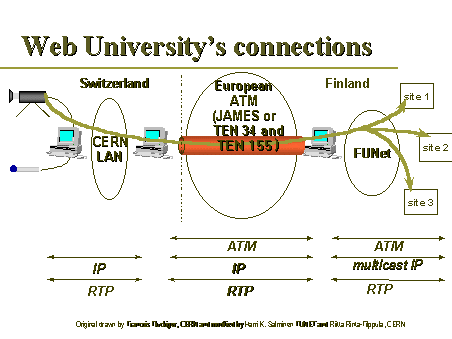Technology
Using European Networks
The Web University -project started by transmitting selected lectures of the CERN training programme to Finnish universities. ISDN was used for the first transmissions, but since June 1996 the Web University became a customer of JAMES (Joint ATM Experiment on European Services). JAMES provided an international ATM connection for the Web University untill the end of March 1998. A point to point connection with an allocated communication speed 2 Mbps between CERN and Finland was used. The JAMES network was constantly under development and worked reasonable well. At the end of the year 1997, WU has started to use TEN-34 . TEN-34 worked well and it was replaced by TEN-155 in January 1999.

The figure explains the Web University connections to Finland. The transmissions takes place also to other countries. In the Web University distance learning sessions, following countries have been involved: Holland, Italy and Slovakia. The same technology has also been used in CERN document management system TUOVI's distance usability tests.
Distance learning sessions are recorded digitally using RealVideo. The
recordings are available from Web
University pages at CERN
Webcast server and form mirror sites in Finland
Technology in Switzerland
- Cern : In the CERN main auditorium is a Silicon Graphics Indy
(180 MHz) equipped with a Gallileo video card. The workstation is connected
to CERN internal IP multicast backbone. A Sun SparcStation 20 (75 MHz)
equipped with a FORE ATM card, acts as a gateway using rtptrans reflector
software between CERN's internal IP multicast backbone and the connection
to Helsinki. A Sun SparcStation 20 (75 MHz) records the sessions using
the Wrtp VoD
-software. Technical contacts: Christian Isnard (Christian.Isnard@cern.ch)
Technology in Finland
- Finnish University and Research Network Funet
multicasts lectures to universities in Finland. FUNET backbone's communication
speed is currently 155 Mbps, and the network is based mainly on ATM.
FUNET uses a SUN SS20SX workstation as a gateway between the
European network and the multicast transmission in the FUNET ATM based IP-backbone.
For local transmissions FUNET uses mostly SGI workstations like 02,
Indy and Indigo as well as a PC running Linux. Technical contacts: Harri Salminen
(mice-nsc@nic.funet.fi)
- Helsinki Institute of Physics HIP
uses a Silicon Graphics O2 with Voicecrafter 3000 echo cancelling
system, uni-directional microphone, table microphone and Sony SMS-IP -loudspeaker.
Silicon Graphics workstation is connected to NetUPS power supply. There is
also a InFocus video projector in order to get a large picture on the wall
in a multimedia conference room.
- Helsinki University of Technology HUT
uses a PC with Linux operating system and a video screen in a conference
room. Technical contacts: Ursula Holmstrom (ursula@iki.fi)
- Tampere University of Technology TUT
uses a Sun ULTRA 10 -workstation with VoiceCraft 2000 echo canceling
system, Genelec loudspeaker and BARCO video screen. Technical contacts: Pasi
Häkkinen (ph@butler.cc.tut.fi).
- Oulu Institute
of Technology uses two Sun Sparc workstations in different rooms.
The workstations are equipped with 20" displays. Technical contacts: Jukka
Orajarvi (jukka.orajarvi@otol.fi)
- University of Oulu
uses a Digital ALPHA -workstation 255 (233 Mhz/128 Mb) or a 120 Mhz
Intel Pentium. Technical contacts: Antti Keranen (antti.keranen@oulu.fi)
- University of Jyvaskyla
uses two Silicon Graphics workstations adjacent to a dedicated videoconferencing
class. Incoming screens are displayed using one workstation by using a video
projector. The control displays are run remotely in the another workstation.
Technical contacts: Veli-Pekka Tahvanainen (vpt@cs.jyu.fi)
Technology in Netherlands
Technology in Italy
Technology in Slovakia
Modified 6.11.2000
 Click
here if you see this page without navigation frame.
Click
here if you see this page without navigation frame.

